- You are here:
- Home »
- Training With a Ball
Category Archives for Training With a Ball
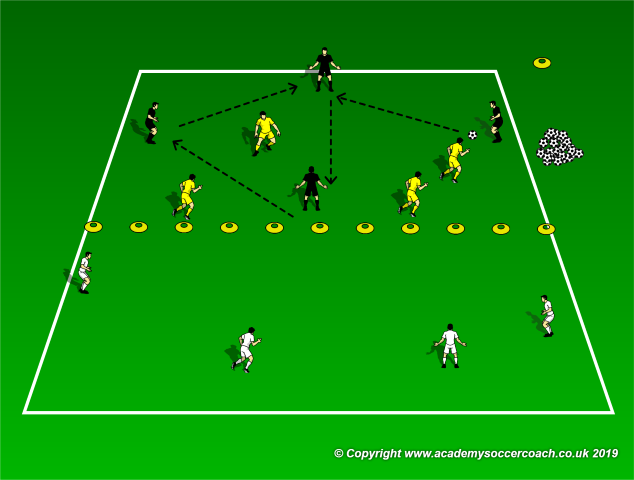
Training the Center Midfielder For Anaerobic Capacity
By Anthony Hazelwood
The following activity has a playing area where a Center Midfielder (CM) will play against three defenders and 4 teammates positioned on each sideline. The CM will be working to adapt their anaerobic capacity through phases of intermittent endurance by being in constant movement for a minute at a time. The grid will be 18 x 18 and may be modified to the coach’s convenience. To start, a CM will be located on the inside of the grid along with four teammates located on each sideline. Three defenders will then be added. Once inside, the CM and teammates will keep possession by circulating the ball and combining. When the defending team retains possession of the ball it is restarted with the attacking team as quick as possible. Once the 1-minute repetition is complete, switch the CM player with another midfield player.
When preparing the activity, if needed, concentration and difficulty levels may be increased by having players execute something extra unique by setting more restrictions. Every activity may be modified, and it is up to the coach to be creative. However, it is important to respect the parameters of the exercise time, the rest, the types of actions used and the weekly periodization of the activity.
Additionally, it is beneficial to train a soccer team and its players with all the elements of the game is present in the session. By doing so, it will promote soccer specific adaptations to the player’s body, mind, and emotional triad. Ultimately, these adjustments will enhance their real-time game performances on a physical, emotional, conscious, and subconscious mental level.
Area Size: 18 d. x 18 yd.
Total Activity Time: 12 minutes.
Sets: 1.
Number of Repetitions: 10
Activity Repetition Time: 1-minute seconds
Recovery Interval Time between reps: 10 seconds.
Intensity: High.
Objectives:
• Tactical: Movement on and off the ball of the CM. Attacking shape and circulation.
• Fitness: Maintain high intense corporal actions.
• Technique: Proper fitness and off/on the ball execution/techniques.
• Mental-Emotional: Players fully engaged and concentration is high.
• Concentration Level: High.
Setup:
• Create an 18 x 18-yard grid.
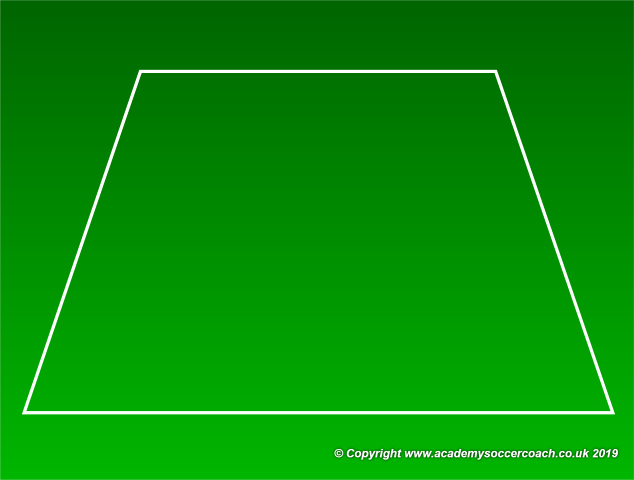
• Create a team five and one team of three.
• From the team of five, locate four players on each sideline and one CM in the middle.
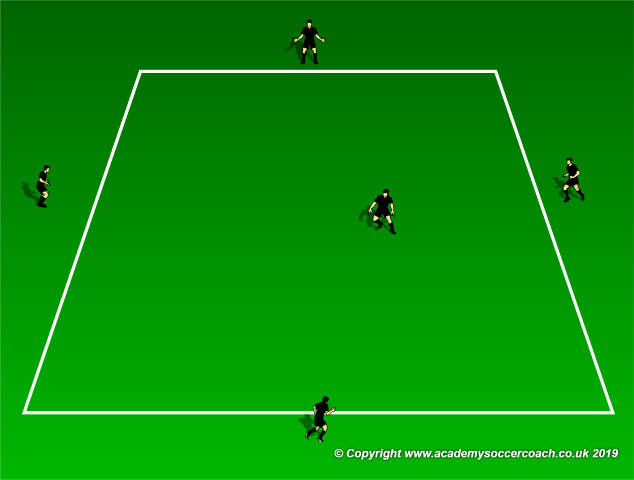
• Team of three, place three defenders in the middle.
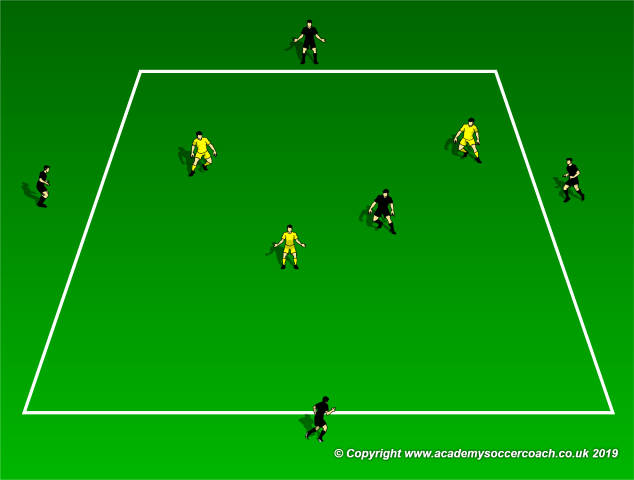
• On whistle, give ball to the attacking team. The team in possession plays a 5 vs. 3 with sideline restrictions.
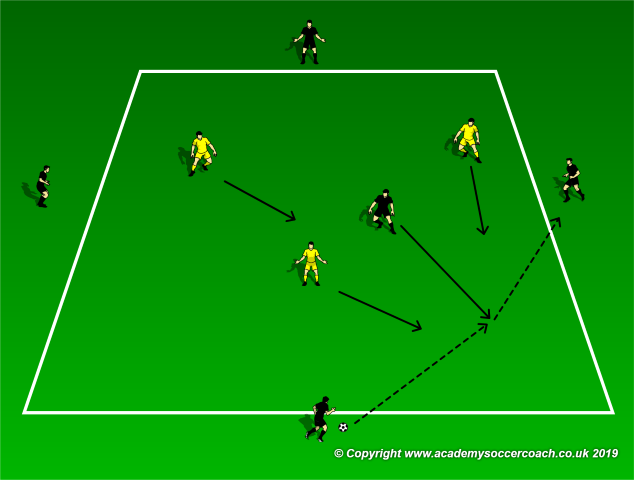
• On a turnover, the defending gives possession back.
• This will last for 1 minute. 10 seconds in between reps and quickly begin again.
Activity Progression:
• Play a one touch with the outside player and two touch on the inside restriction.
• One touch everywhere.
Coaching Points:
• CM movement on and off the ball.
• Supporting player on ball with proper angles.
• Aggressive defending behaviors.
• Pressure and cover defending principles.
• Keep track of time, 30 second on – 30-second rest.
• High intensity.
• Proper technique and Proper Exercise Movement.
By Anthony Hazelwood
Coach Anthony is a USSF “A” licensed coach with an M.S. in Sports Training and Nutrition and a B.S. in Physical Education. Currently, he is an Assistant and Sports Performance coach with the Miami FC. He has previous European youth academy coaching experience as a soccer fitness and strength/conditioning assistant coach with Levante U.D. and Getafe SAD in Valencia and Madrid, Spain.
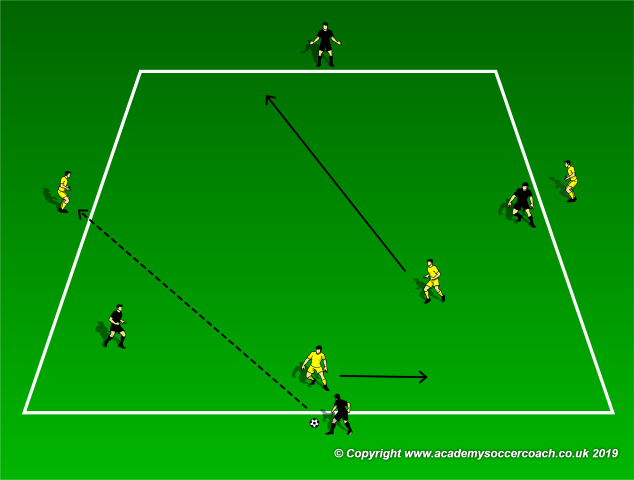
Speed Development With Shadow Play 3vGK
By Anthony Hazelwood
The following activity has three lines of players working on patterns of play. Players will be working to adapt their speed production within the creatine phosphate system. Play will begin from the attacking middle third area. To begin, three lines of players will work on different patterns of play to goal. The important factor here is the speed of play the activity is performed in. Make sure sprints are maximal.
When preparing the activity, if needed, concentration and difficulty levels may be increased by having players execute something extra unique by setting more restrictions. Every activity may be modified, and it is up to the coach to be creative. However, it is important to respect the parameters of the exercise time, the rest, the types of actions used and the weekly periodization of the activity.
Additionally, it is beneficial to train a soccer team and its players with all the elements of the game is present in the session. By doing so, it will promote soccer specific adaptations to the player’s body, mind, and emotional triad. Ultimately, these adjustments will enhance their real-time game performances on a physical, emotional, conscious, and subconscious mental level.
Area Size: Half a field.
Total Activity Time: 15 minutes.
Sets: 3
Number of Repetitions: 9 (three reps on each cone.)
Intensity: High.
Objectives:
• Tactical: Patterns of play.
• Fitness: Maintain high intense corporal actions.
• Technique: Proper fitness and off/on the ball execution/techniques.
• Mental-Emotional: Players fully engaged and concentration is high.
• Concentration Level: High.
Setup:
• Put three cones at the attacking third portion of the field.
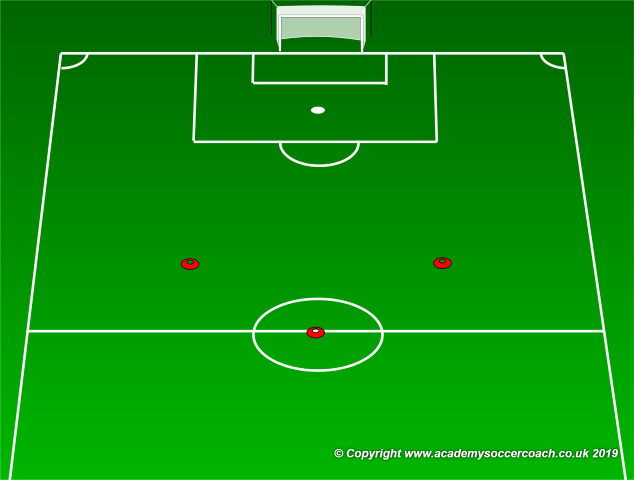
• Put players on cones.
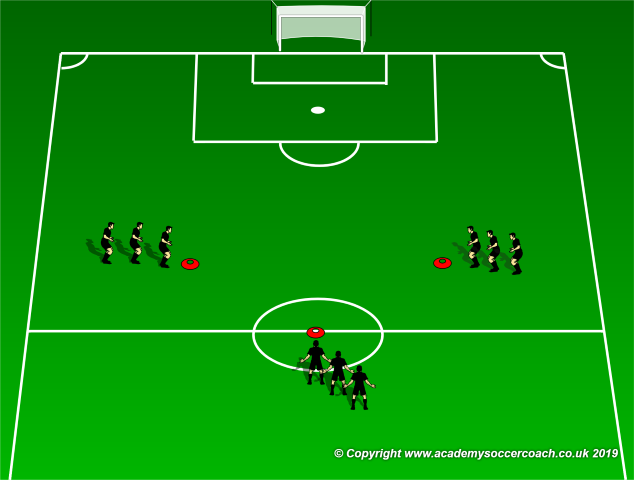
• Perform Pattern #1: Repeat on Both Sides.
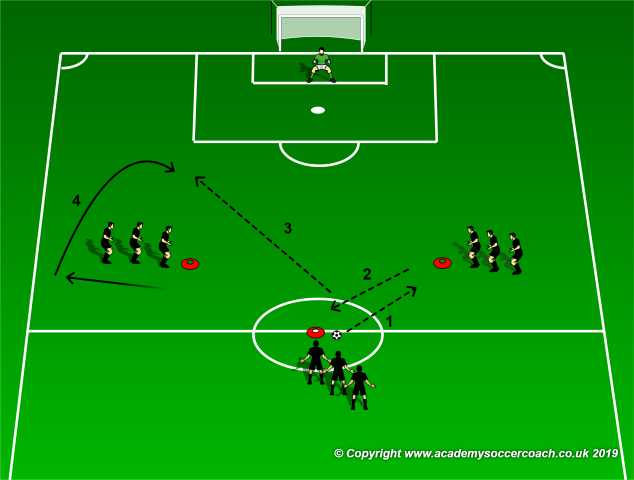
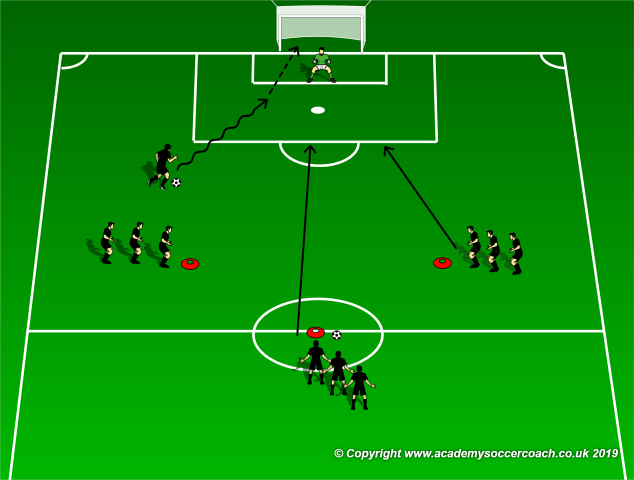
• Perform Pattern #2: Repeat on Both Sides
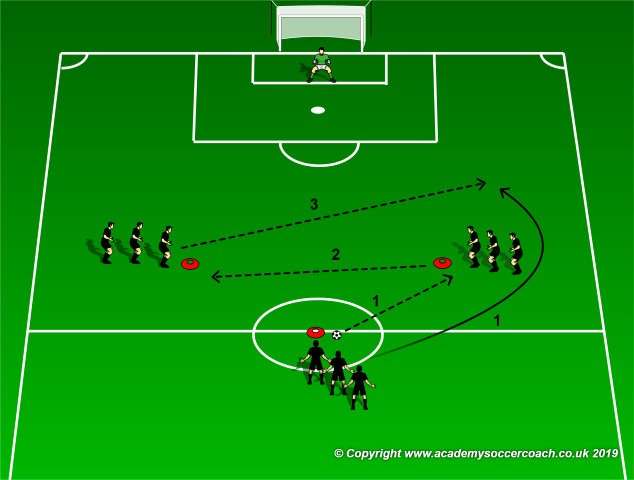
6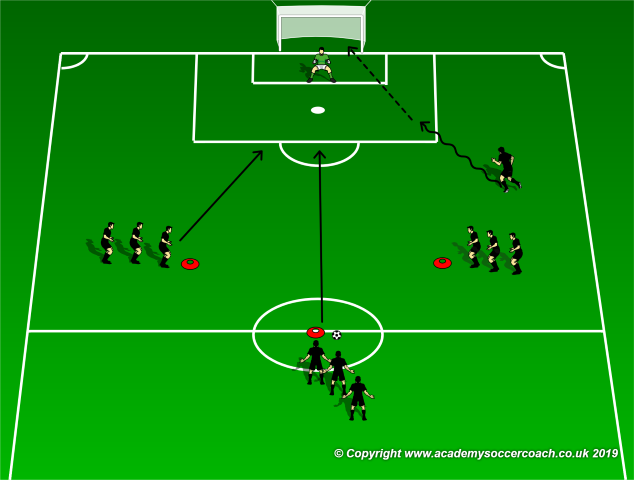
Coaching Points:
• Technical and Tactical executions at speed.
• Timing of runs.
• Keep lines at proper work to rest ratio. Players need more rest to recover to perform the action maximally again.
By Anthony Hazelwood
Coach Anthony is a USSF “A” licensed coach with an M.S. in Sports Training and Nutrition and a B.S. in Physical Education. Currently, he is an Assistant and Sports Performance coach with the Miami FC. He has previous European youth academy coaching experience as a soccer fitness and strength/conditioning assistant coach with Levante U.D. and Getafe SAD in Valencia and Madrid, Spain.

Anaerobic Capacity Three teams 4v4 Possession Game
By Anthony Hazelwood
The following activity has three teams of four players playing a possession game. Players will be working to adapt their anaerobic capacity through intermittent endurance. A 30-length x 50-yard width split into a half will be built. To begin, two teams will be located on one side of the activity grid as the offensive teams. The other team will be playing as the defensive team and located on one side of the grid.
The objective of the activity is to maintain possession and to switch play when the passing restriction has been broken. Once this is done the defending team moves to the other side of the grid to defend the other team. If the defending team wins the ball, then they become the attacking team. The team that lost the ball will turn into the defending group.
When preparing the activity, if needed, concentration and difficulty levels may be increased by having players execute something extra unique by setting more restrictions. Every activity may be modified, and it is up to the coach to be creative. However, it is important to respect the parameters of the exercise time, the rest, the types of actions used and the weekly periodization of the activity.
Additionally, it is beneficial to train a soccer team and its players with all the elements of the game is present in the session. By doing so, it will promote soccer specific adaptations to the player’s body, mind, and emotional triad. Ultimately, these adjustments will enhance their real-time game performances on a physical, emotional, conscious, and subconscious mental level.
Area Size: 30 yds. length x 50 yds. width.
Total Activity Time: 16 minutes.
Sets: 1.
Number of Repetitions: 5
Activity Repetition Time: 2 minutes.
Recovery Interval Time: 1 minute.
Intensity: High.
Objectives:
• Tactical: Quick supporting actions to maintain possession to switch play.
• Fitness: Maintain high intense corporal actions.
• Technique: Proper fitness and off/on the ball execution/techniques.
• Mental-Emotional: Players fully engaged and concentration is high.
• Concentration Level: High.
Setup:
• Create a grid that is 30 yds length and 50 yds. width split down the middle.
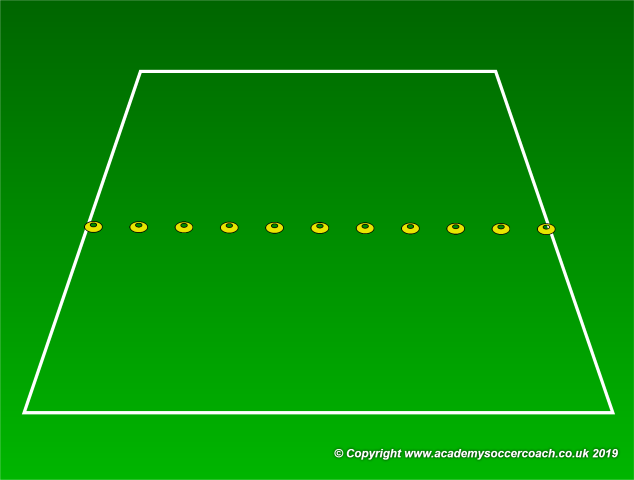
• Two teams of four players located on each side of the grid.
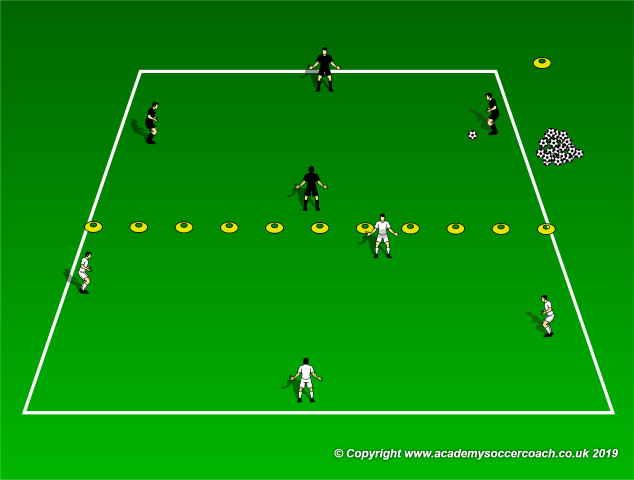
• One defensive team ready to commence vs. another team.
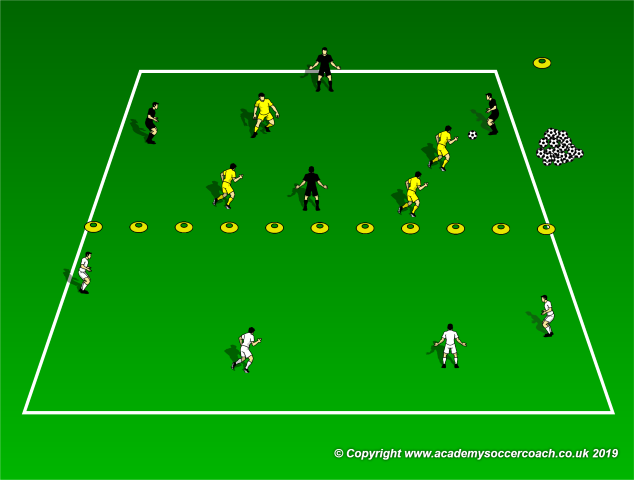
• At the whistle, the run of play will commence.
• The team in attack will have to make four passes before the ball may be passed to the other team.
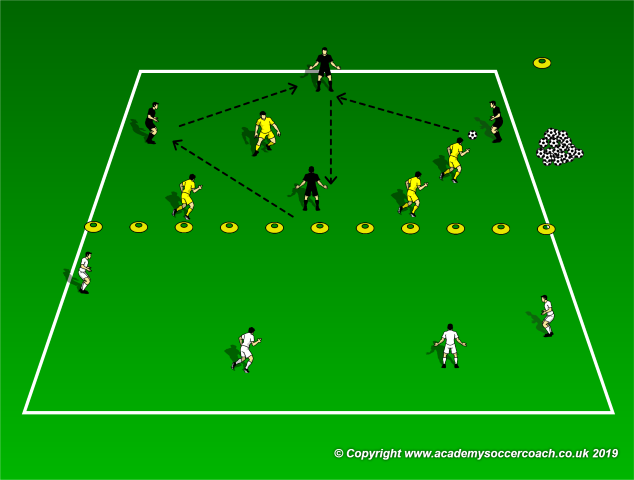
• Once this is done, the defending team moves quickly to the other half and defends.
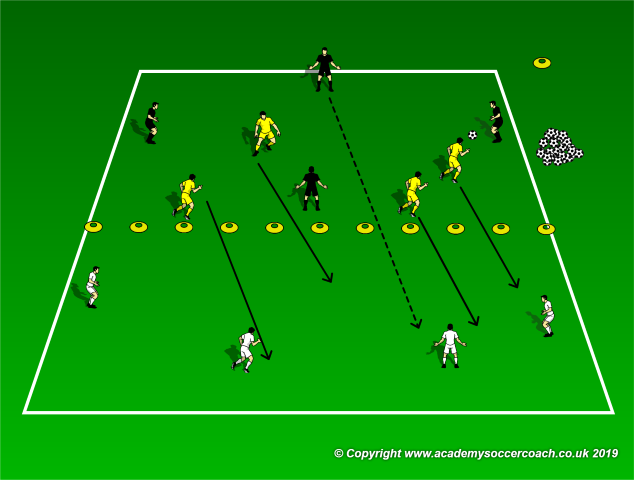
• If the team successfully takes the ball away, then they pass to the other grid and stay as the team in offense.
Coaching Points:
• Attentiveness.
• Keep track of time, 2 minutes play – 1 minute rest.
• High intensity.
• This session is continuous for two minutes, make sure to keep moving.
• Proper technique and Proper Exercise Movement.
• Proper exercise movements when attacking players are idle.
• If progressions are needed: After every pass a five yard sprint must be completed – Team waiting in the attack needs to perform some kind of upper body exercise until the ball is switched.
By Anthony Hazelwood
Coach Anthony is a USSF “A” licensed coach with an M.S. in Sports Training and Nutrition and a B.S. in Physical Education. Currently, he is an Assistant and Sports Performance coach with the Miami FC. He has previous European youth academy coaching experience as a soccer fitness and strength/conditioning assistant coach with Levante U.D. and Getafe SAD in Valencia and Madrid, Spain.
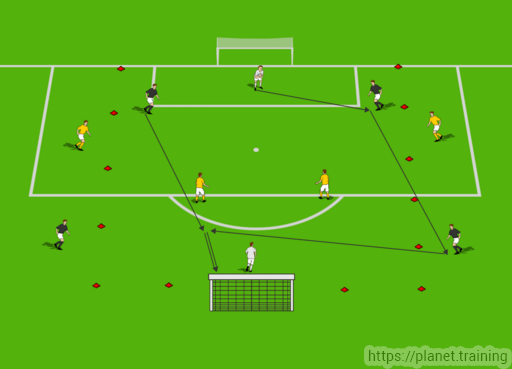
2v2 Strength Game
By Anthony Hazelwood
The following activity has individual players working on their soccer specific muscle strength. A two vs. two player session with two GK’s and sideline targets is played in a 28yd. x 23yd. area. One target player is placed for each team on the sidelines and is restricted to one touch play. This is a great activity to work on all moments of the game while working on soccer specific muscle strength actions and developing anaerobic capacity.
When preparing the activity, if needed, concentration and difficulty levels may be increased by having players execute something extra unique by setting more restrictions. Every activity may be modified, and it is up to the coach to be creative. However, it is important to respect the parameters of the exercise time, the rest, the types of actions used and the weekly periodization of the activity.
Additionally, it is beneficial to train a soccer team and its players with all the elements of the game being present in the session. By doing so, it will promote soccer specific adaptations to the player’s body, mind, and emotional triad. Ultimately, these adjustments will enhance their real-time game performances on a physical, emotional, conscious, and subconscious mental level.
Area Size: 28yd. x 23 yd. area.
Total Activity Time: 16 Minutes.
Sets: 1.
Activity Time: 2 minutes.
Recovery Interval Time: 2 minutes (become sideline players).
Intensity: High.
Objectives:
• Tactical: Attack – Mobility, anticipate ad look to score; Defense – Pressure and cover, Stop shots.
• Fitness: Maintain high intense corporal actions.
• Technique: Proper fitness and off/on the ball execution/techniques.
• Mental-Emotional: Players fully engaged and concentration is high.
• Concentration Level: High.
Setup:
• Create a 28 yd. x 23 yd. area.
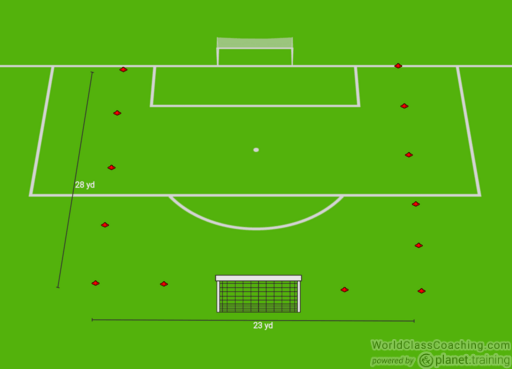
• Two vs. two players in the playing area with big goals.
• Two GK’s and one sideline target player for each team.
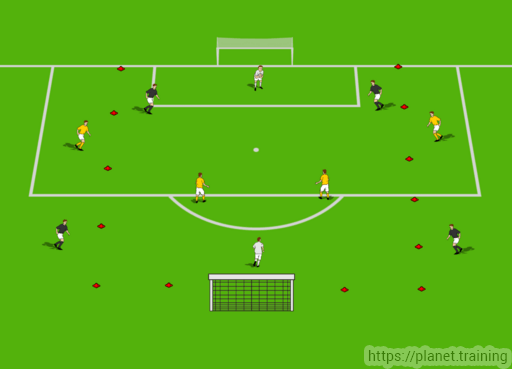
• Play for two minutes.
• Sideline target players play one touch and starting positions should be closer to their team’s goal.
• If players have a clear shot on goal, then they should execute it.

• After two minutes rotate sideline players to play inside and visa-versa.
By Anthony Hazelwood
Current Seattle Sounders Academy Performance Coach with previous European academy coaching experience as an assistant fitness and strength/conditioning soccer coach with Levante U.D. (2013-2014) and Getafe SAD CF (2015-2016) in Valencia and Madrid, Spain respectively. A USSF “A” licensed coach with a BSc in Physical Education and an MSc in Sports Training and Nutrition.

Defend in a Deep Lying Block Defense – Aerobic Power
By Anthony Hazelwood
Defend in a Deep Lying Block Defense – Aerobic Power. Defend in a Deep Lying Block Defense – Aerobic Power. The following activity coaches a team to defend in a deep lying block defense. The specific fitness target is transient endurance while adapting the player’s aerobic power in an extended small-sided format.
When preparing the activity, if needed, concentration and difficulty levels may be increased by having players execute something extra unique by setting more restrictions. Every activity may be modified, and it is up to the coach to be creative. However, it is important to respect the parameters of the exercise time, the rest, the types of actions used and the weekly periodization of the activity.
Additionally, it is beneficial to train a soccer team and its players with all the elements of the game being present in the session. By doing so, it will promote soccer specific adaptations to the player’s body, mind and emotional triad. Ultimately, these adjustments will enhance their real-time game performances on a physical, emotional, conscious, and subconscious mental level.
Area Size: 50 yds. Length X 60 yds. Width
Total Activity Time: 20 Minutes.
Sets: 1.
Intervals: 3. Activity Time: 6 minutes.
Recovery Interval Time between Sets: 1 minute.
Intensity: High.
Objectives:
• Tactical: Defend as a team in a deep lying block defense. Defensive individual, small group and team collective defending principles of play.
• Fitness: Aerobic Power. Ability to play through three repetitions at a high rate.
• Technique: Proper fitness and off/on the ball execution/techniques.
• Mental-Emotional: Players fully engaged and concentration is high.
• Concentration Level: High.
Setup:
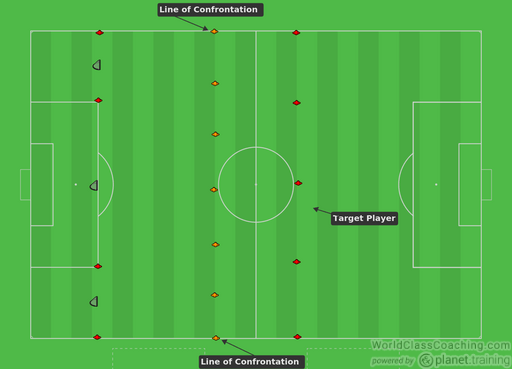
• Yellow team (4-4-1) trains to defend in a low-lying compact box shape.
• There are three goals (6 yds.) placed at the yellow teams end line.
• A Target player is located at the black team’s end line and may only run side to side on the line.
• A line of confrontation is located 30 yds. from the yellow teams end line.
• Yellow team may not defend beyond the line of confrontation.
• Black team (4-2-3) starts with the ball and looks to score through one of the three goals by either passing or dribbling through it.
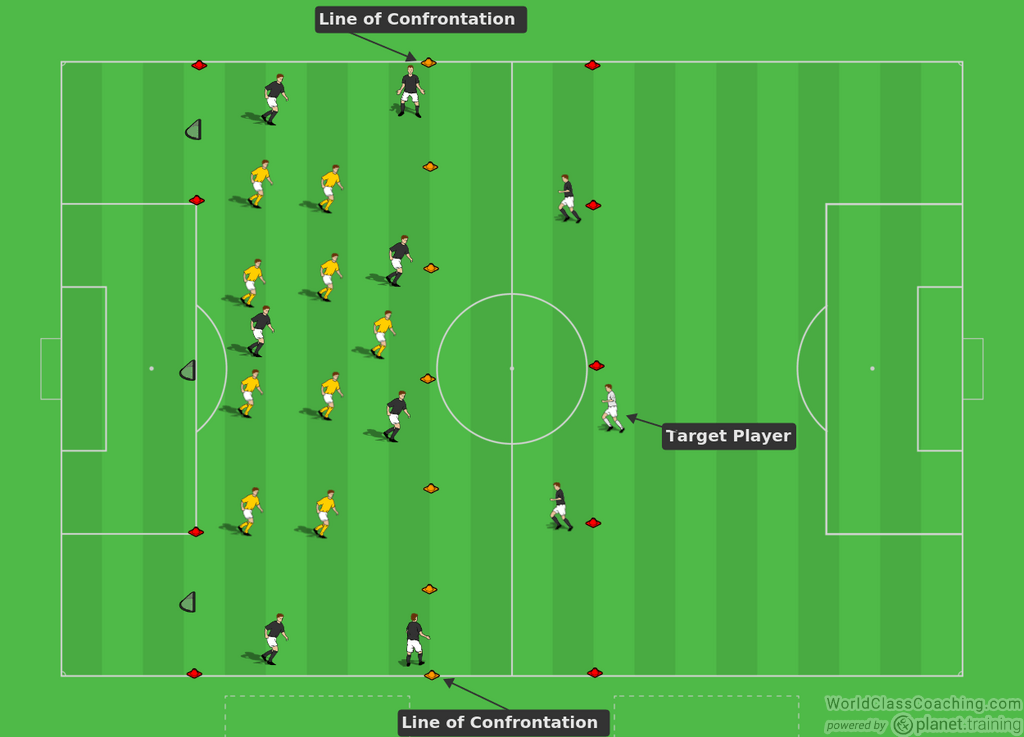
• Yellow team looks to defend the three goals.
• If the defending yellow team wins back the ball, they look to transition into attack and find the target player. They may go beyond their line of confrontation when in possession.
• Once they find the target player, the teams quickly recover below the line of confrontation and begins to defend again.
• Target player plays with black team during possession and is available to receive passes from yellow team when they are in possession.
Coaching Points:
• Defending team works collectively to protect three goals.
• Collective shifting and understanding of roles in zones.
• Pressure, Cover and Balance concepts.
• Team yellow recovers into a deep lying defensive shape after a turn over to the Target player or when taken away by the defending team.
By Anthony Hazelwood
Current Seattle Sounders Academy Performance Coach with previous European academy coaching experience as an assistant fitness and strength/conditioning soccer coach with Levante U.D. (2013-2014) and Getafe SAD CF (2015-2016) in Valencia and Madrid, Spain respectively. A USSF “A” licensed coach with a BSc in Physical Education and an MSc in Sports Training and Nutrition.
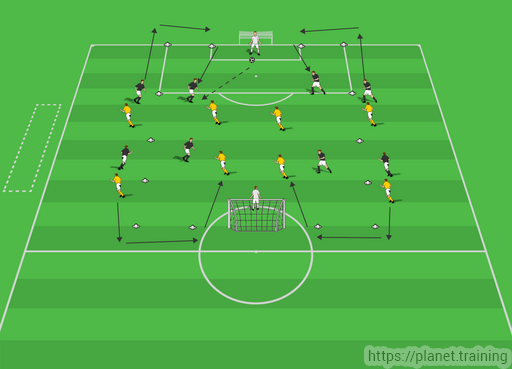
Continuous 4v4 with Capacity to Recover
By Alex Trukan
This game is focused on developing players’ capacity to recover quick bursts. The quicker energy stores will be refuelled, the more intense actions can be produced early. These outcomes are achieved within highly engaging 4v4 games scenario which improve players’ decision making, wide range of technical abilities as well as working as a team. It also challenges players’ concentration and dealing with pressure as the game finishes if one of the teams scores!
Set up and directions
Organise 30 x 45 yards pitch with two goals as shown on the diagram below. Assign goalkeepers to goals. Divide the team into two groups of eight. Then further divide the groups into two teams of four. First two groups start on the pitch, the other two wait on the side of the goals. Prepare a sufficient supply of balls in goals.
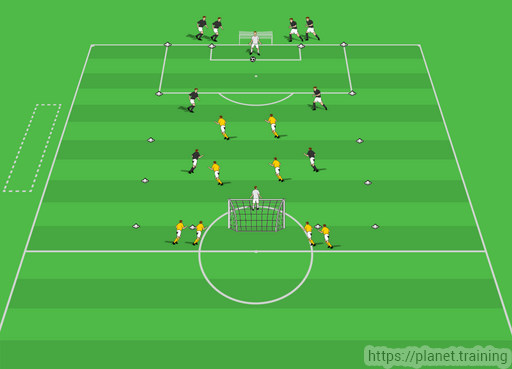
The practice starts with one of the goalkeepers playing the ball out into the attacking team. Then, the game continues with both teams trying to score in the opposite goals. No corners apply – the game is restarted from the goalkeeper.
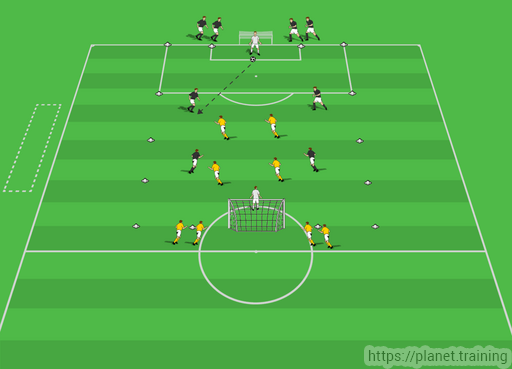
The game continues until one of the teams score a first goal. The pitch is relatively long for this format so direct play and quick combinations should be encouraged. Both teams come off the pitch when the first goal is scored. The team that scored it gets 1 point.
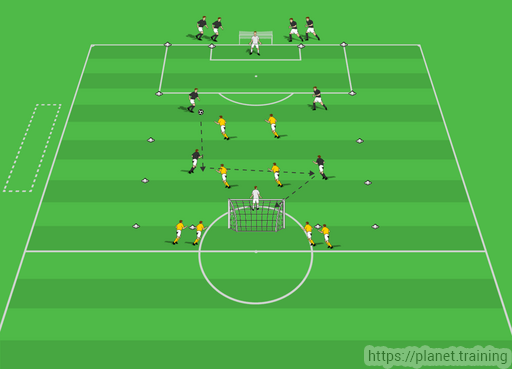
As soon as the goal is scored and two teams come off the pitch, the next two come onto it straight away and the game continuous with new 4v4s. Points from both teams get accumulated and the final score decides the winner.

Timing:
Each team should complete 6-10 repetitions (min. 12 games) in 2 series. Rest between repetitions should be 1-3 minutes and between series – 4 minutes.
Variations:
– 3v3’s
– The quicker the goal is scored the more it is worth (ex. within 1 min. – 3 points)
– No back passes allowed
By Alex Trukan, Development Coach, Nottingham Forest – @AlexTrukan
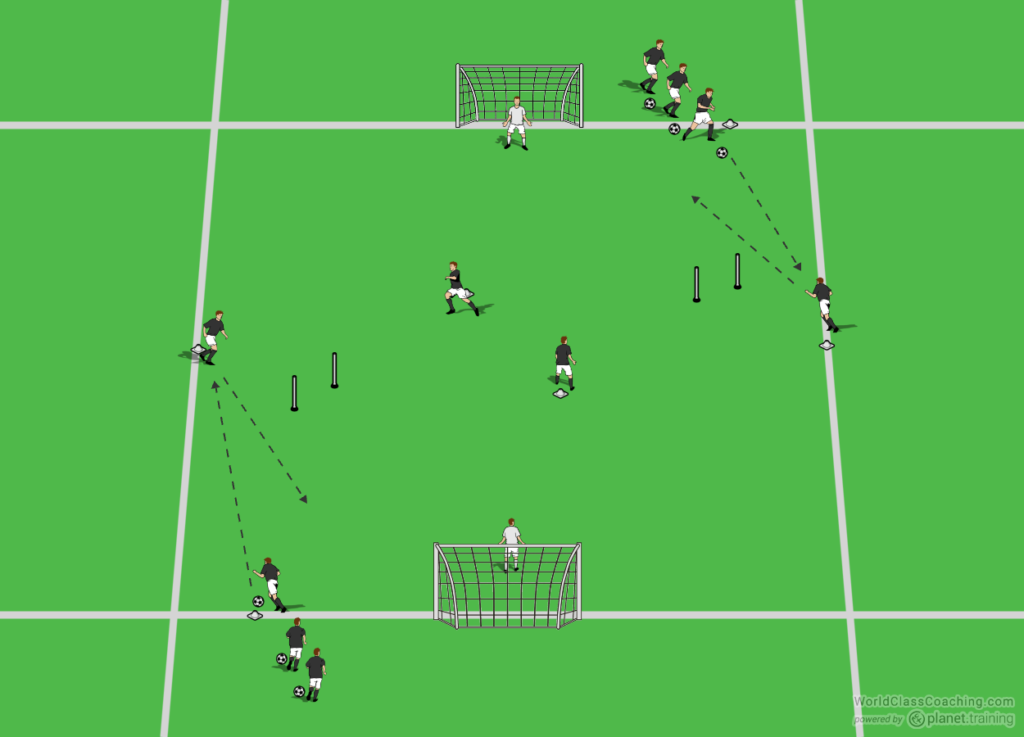
Shooting Combination with Starting Speed
By Alex Trukan
Shooting combination practice involves working on starting speed around the penalty box. This is important for players in order to gain advantage near the goal and be able to get to the ball before the defender. This in turn will help players to get into more goal scoring situations and eventually, score more goals. In this practice, the conditioning element is therefore linked to technical content of finishing as well as combination play in the final third.
Set up and directions
Organise two goals opposite to each other, 30 yards apart. Set up a cone next to the goal which will be starting point of the exercise. Organise further two cones (one on the angle to the left from the starting point and one on the angle to the right). There should be minimum 8-10 yards distance between the cones Set up a gate using two poles as shown on the diagram below. Divide the players into two groups. Set one player each on the cones in the middle and the rest of the players with one ball each on the starting cone. Goalkeepers should be set and ready in goals.
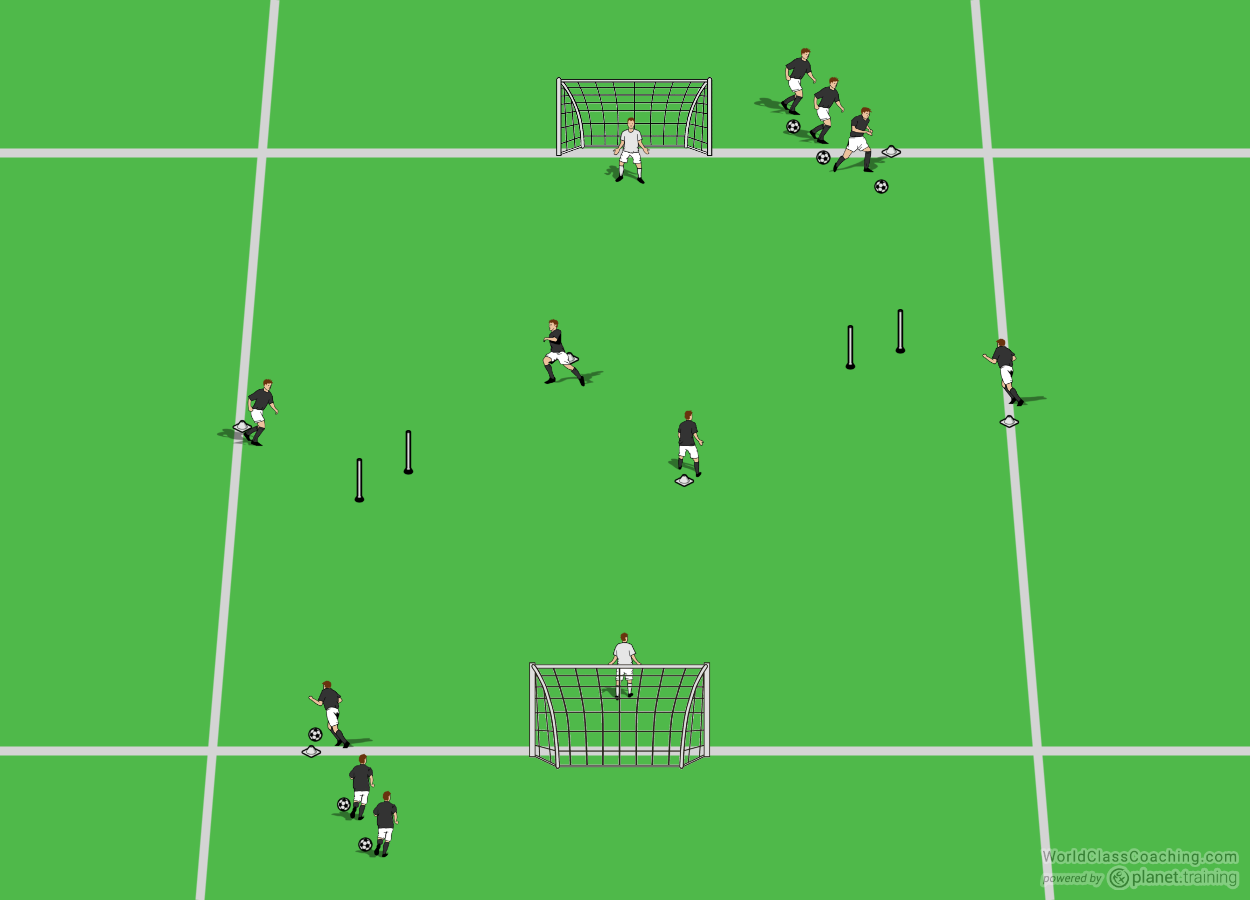
The practice starts with first player with the ball passing it to the player positioned on the cones to his left. The ball is then returned back on the angle using one touch. Both groups start at the same time.
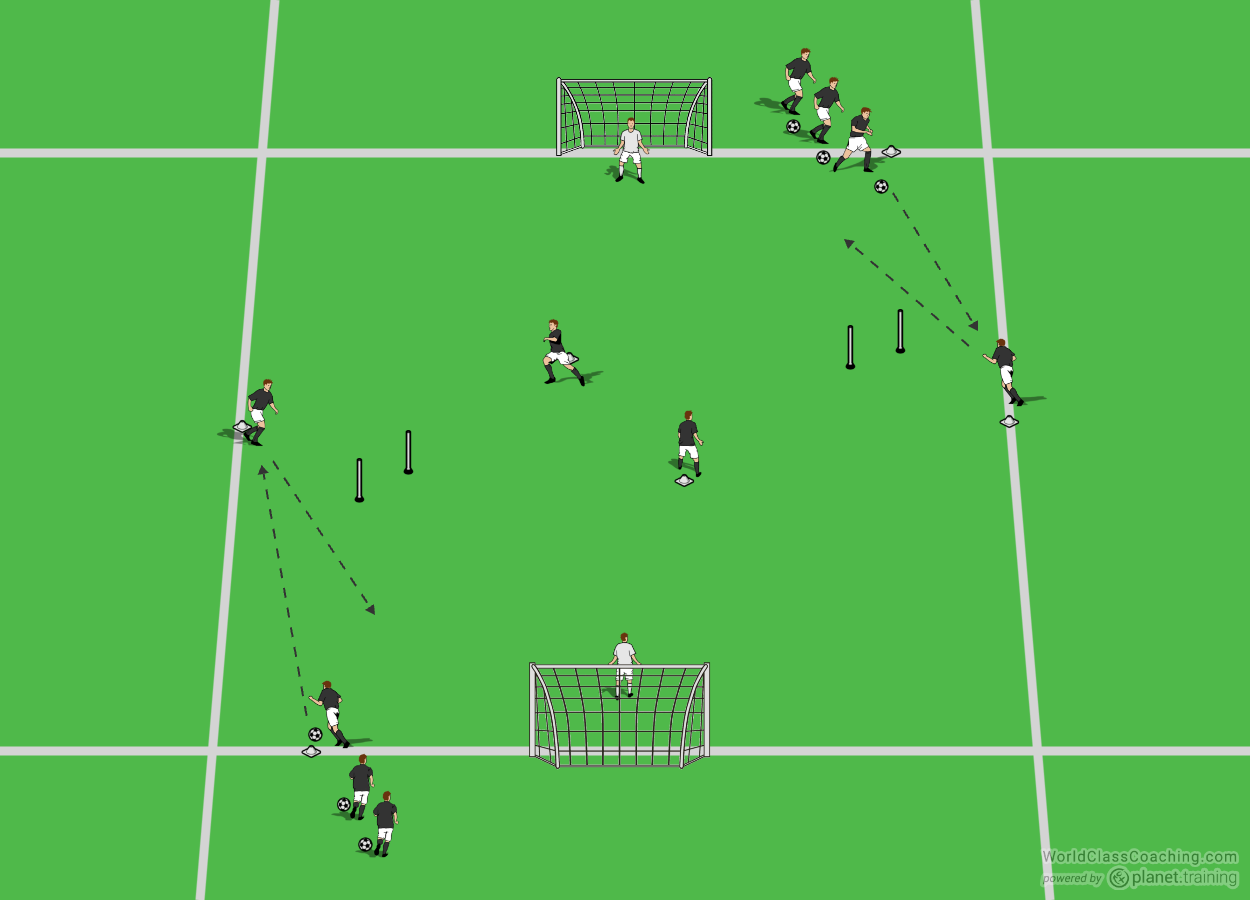
The player that started the practice passes the ball to the player positioned on the cone to his right. This pass is crucial for next sequence of the pattern and therefore should be played with high quality (allowing the receiver to play off one touch).
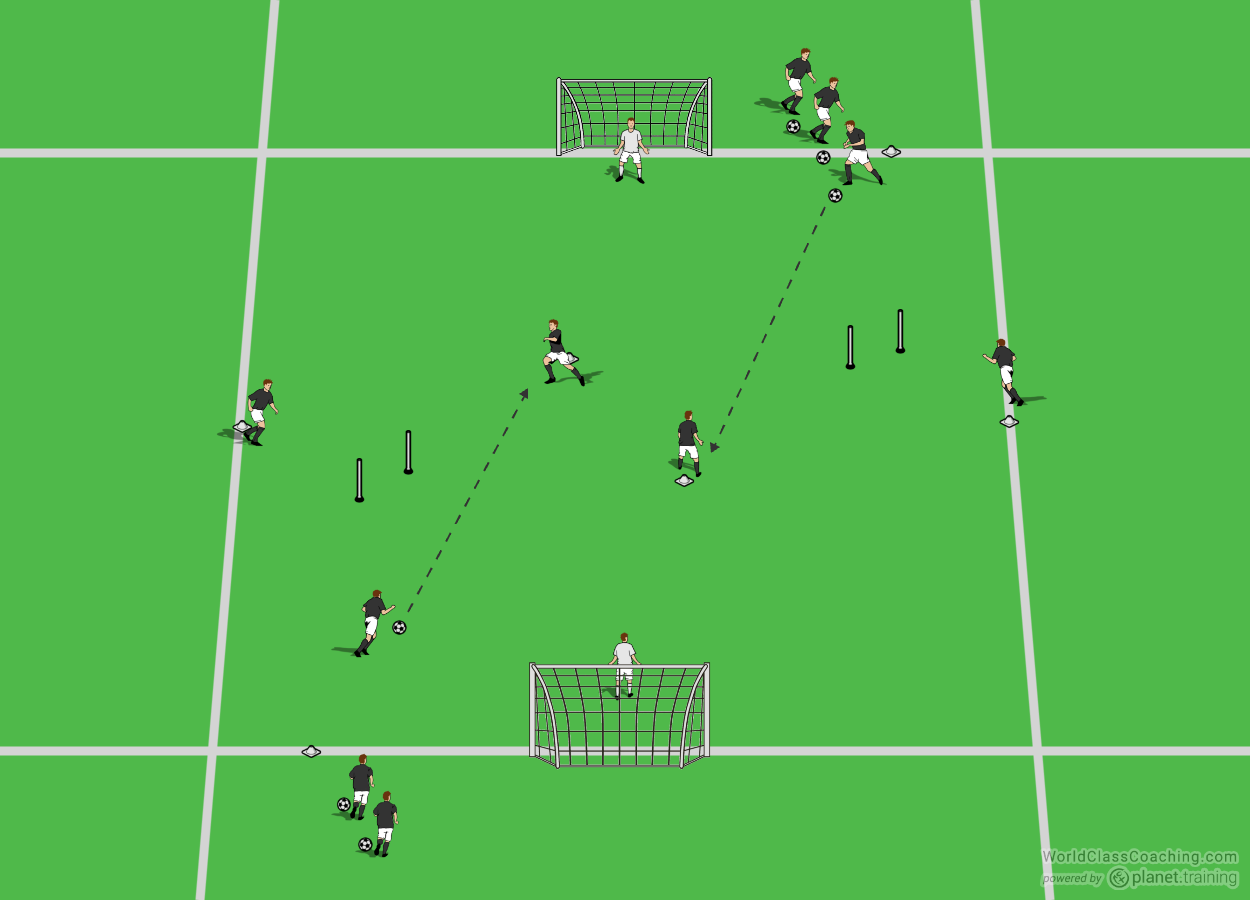
Following that, the receiver sets the ball on the angle. At the same time, the second player in a sequence makes a quick and sharp movement through the gate to then sprint onto the ball and finish in goal. This should be done on maximal speed. Players rotate clockwise (‘starting’ player-‘shooting’ player-‘setting’ player). As soon as one pattern finishes, the next one should start immediately to ensure appropriate work to rest ratios and flow of the practice.
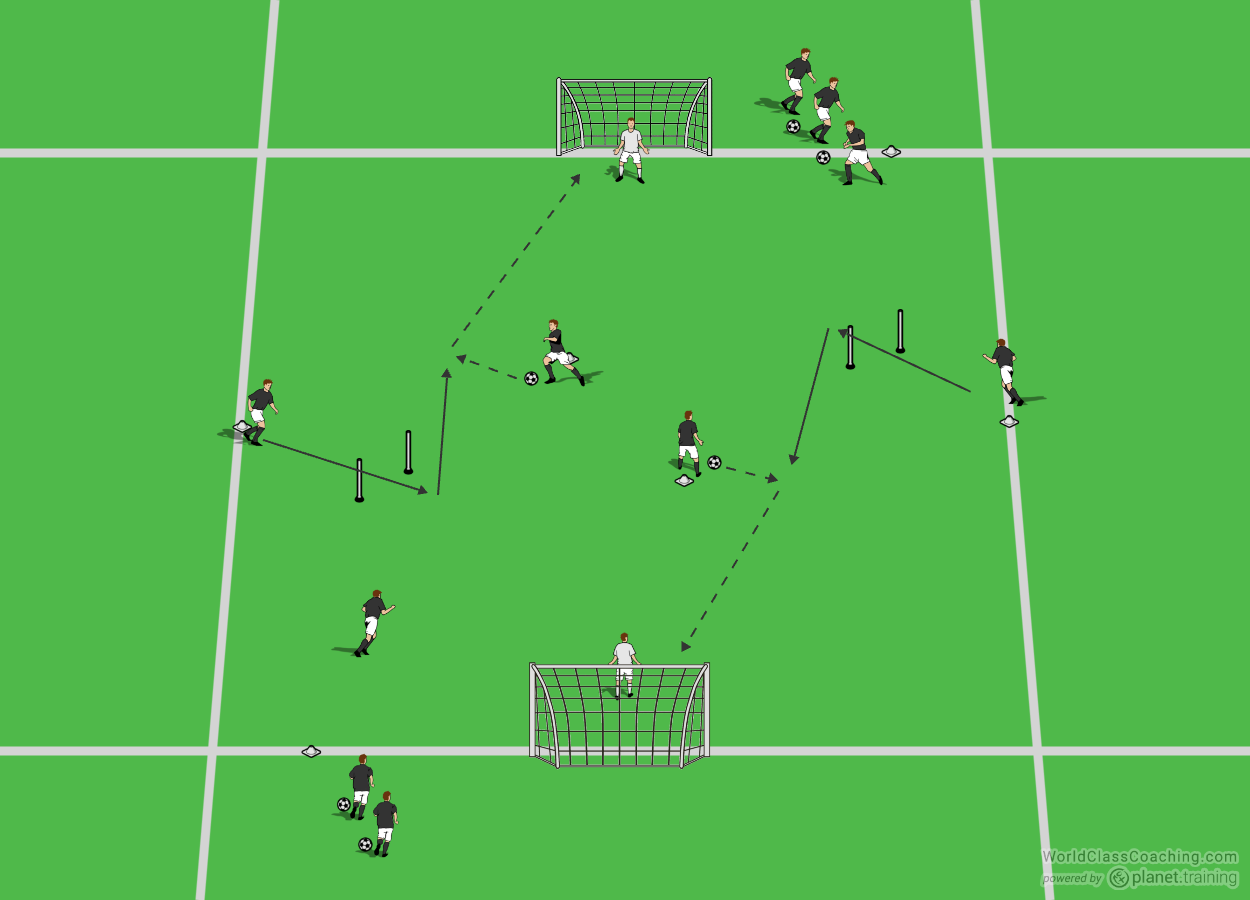
Timing
Each player should make 8-10 repetitions as a ‘shooting’ player. This should be done in 2-4 series with 30 second rest (working as a ‘starting’ or ‘setting’ player) between repetitions and 4 minutes between series.
Variations
- Increase/decrease distances between cones
- Passing off one/two touches
- ‘Shooting’ player passes directly to ‘setting’ player
By Alex Trukan, Development Coach, Nottingham Forest
@AlexTrukan
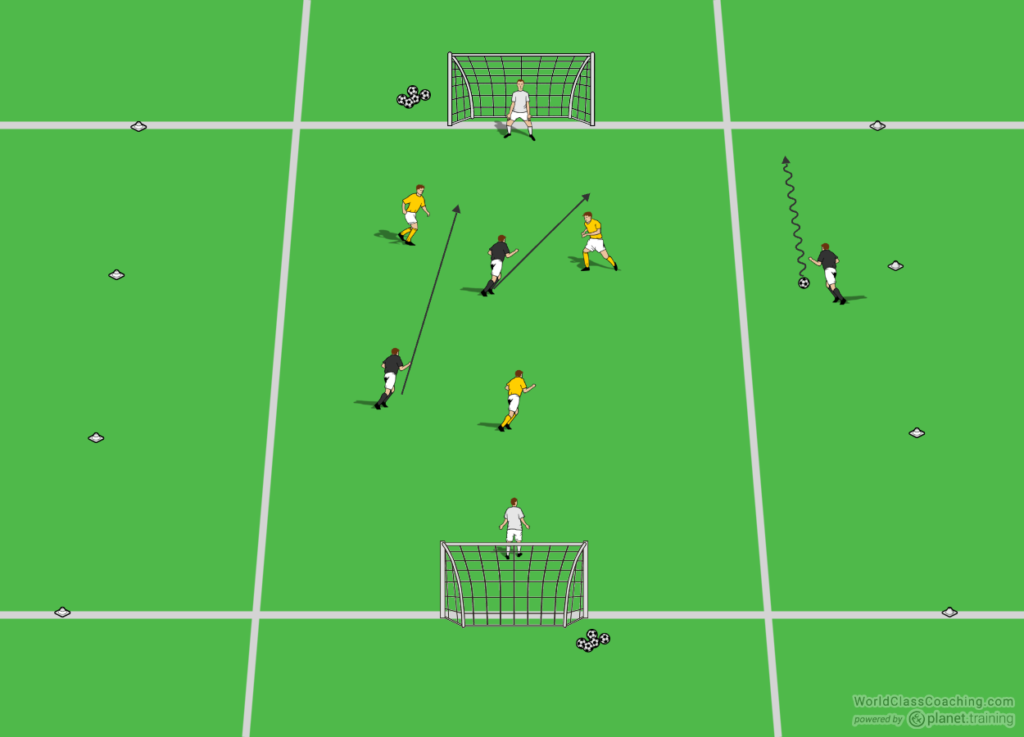
Crossing and Finishing Game
This is one of 28 articles and training sessions on conditioning and other topics that will be published this month in the Training Center. Click Here to learn how you can receive access to all of them.
By Alex Trukan
This practice is designed to improve players’ ability to recover between high intensity actions in a most efficient way. This will allow players to sustain the quality (speed and strength) of their actions for longer throughout the game. These physical outcomes are achieved in a highly technically demanding game containing a lot of crossing and finishing. Small amount of players on each side ensure high intensity and engagement of the players.
Set Up and Directions
Organise a pitch of 25 x 20 yards with three zones – two wide zones (5 yards wide each) and central zone (15 yards wide). Set up two goals on the opposite ends as shown on the diagram below. Divide the group into two teams of three. Set the goalkeepers in goals. Prepare a sufficient supply of balls to ensure flow of the practice.
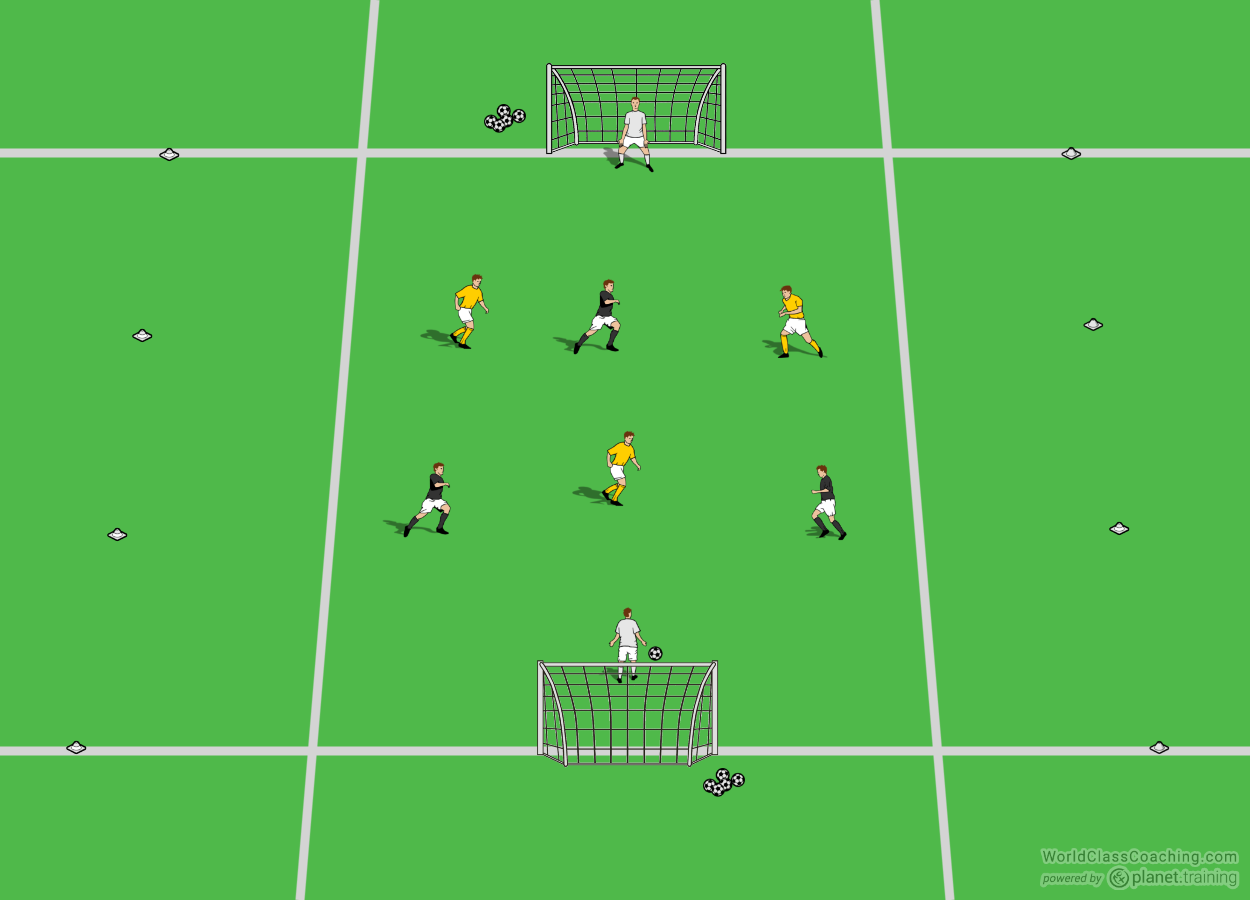
The practice starts with a goalkeeper passing to any of the teams. After this, the aim of the team in possession is to make 3 consecutive passes. This should be completed in the middle part of the pitch.
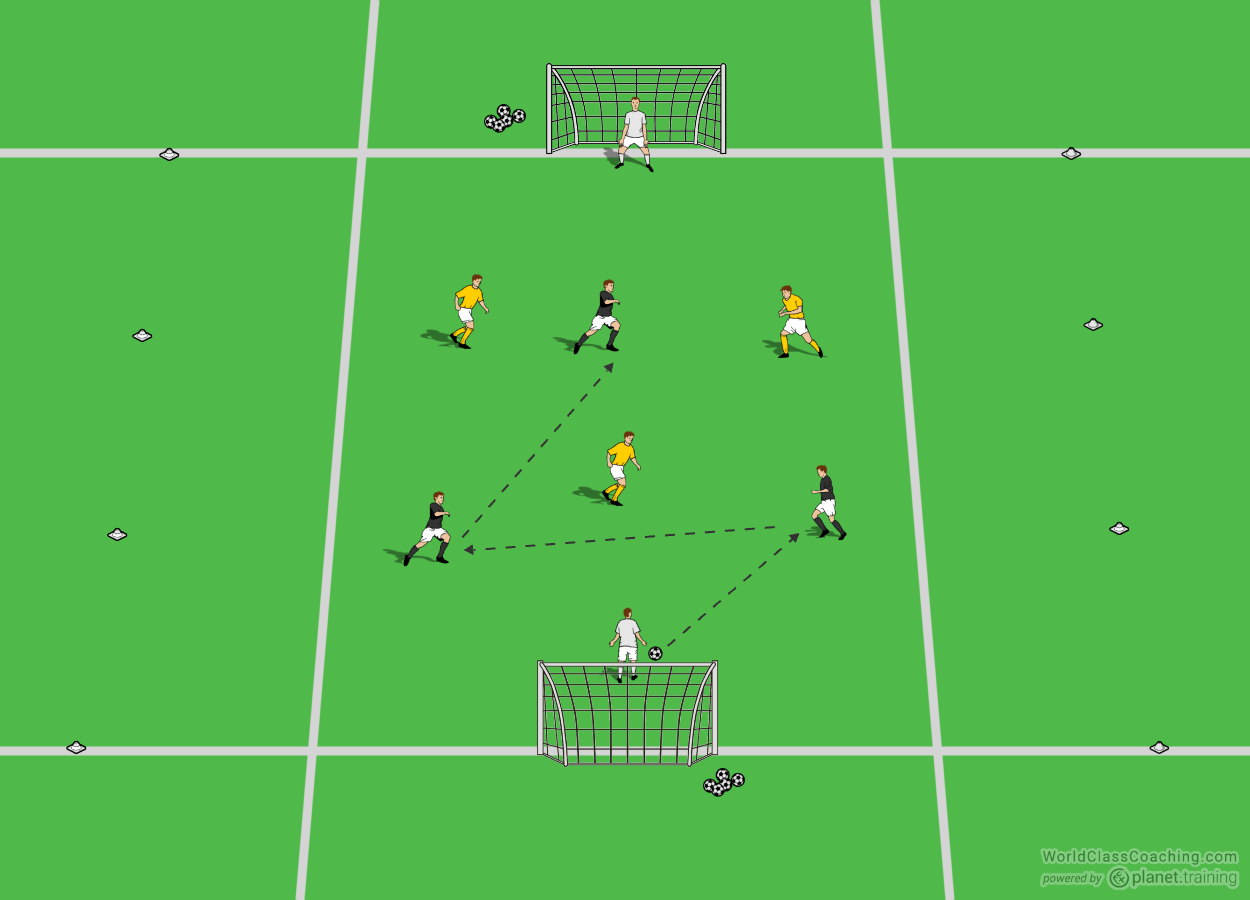
As soon as the 3 passes are made, the ball can be played into one of the wide areas to the player making a movement there (max. two attacking players can be in one wide area). Only one defender can tackle in wide area.
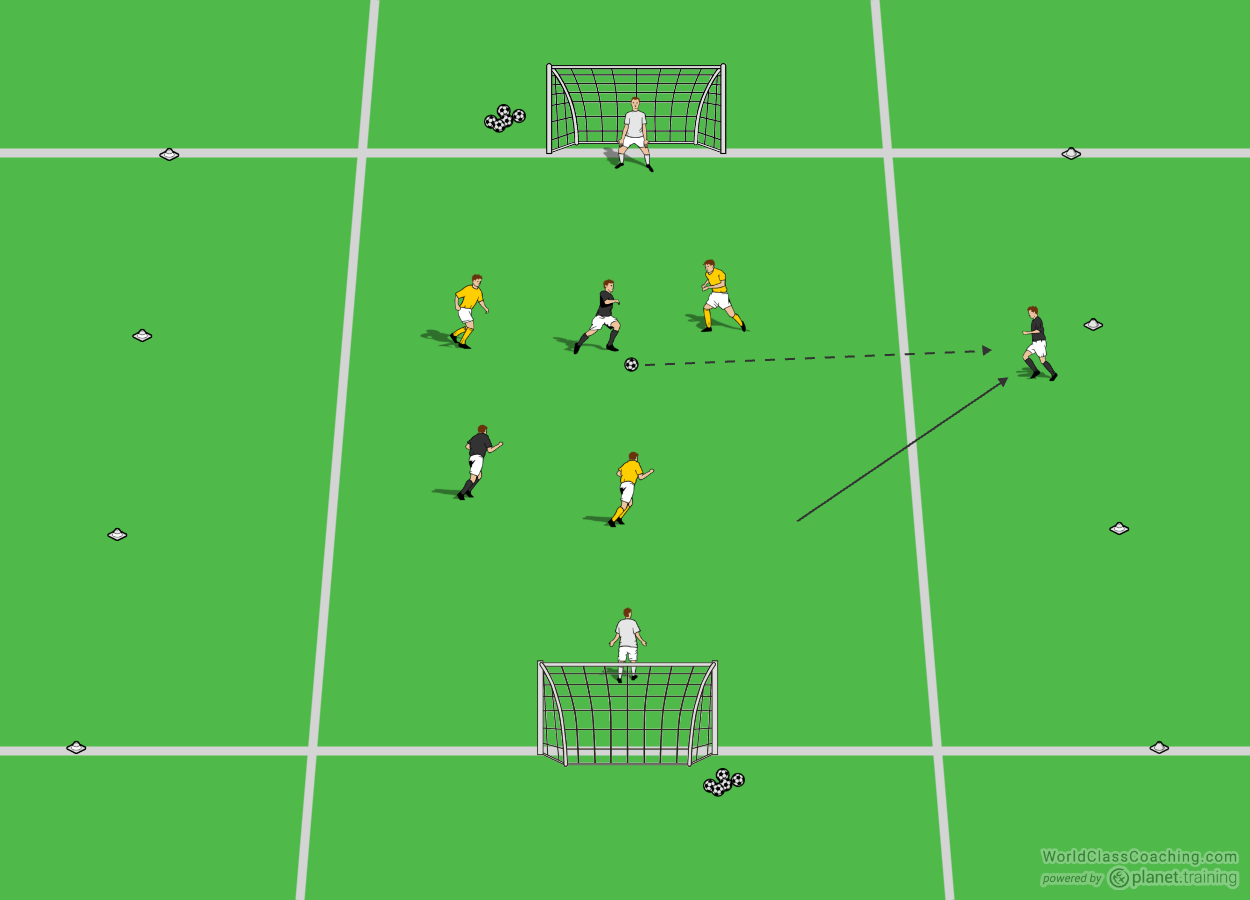
The attacking team can have only three entries into wide areas per attack what will encourage quicker turn overs of possession and more crosses. The ball can be delivered both aerially and on the ground.
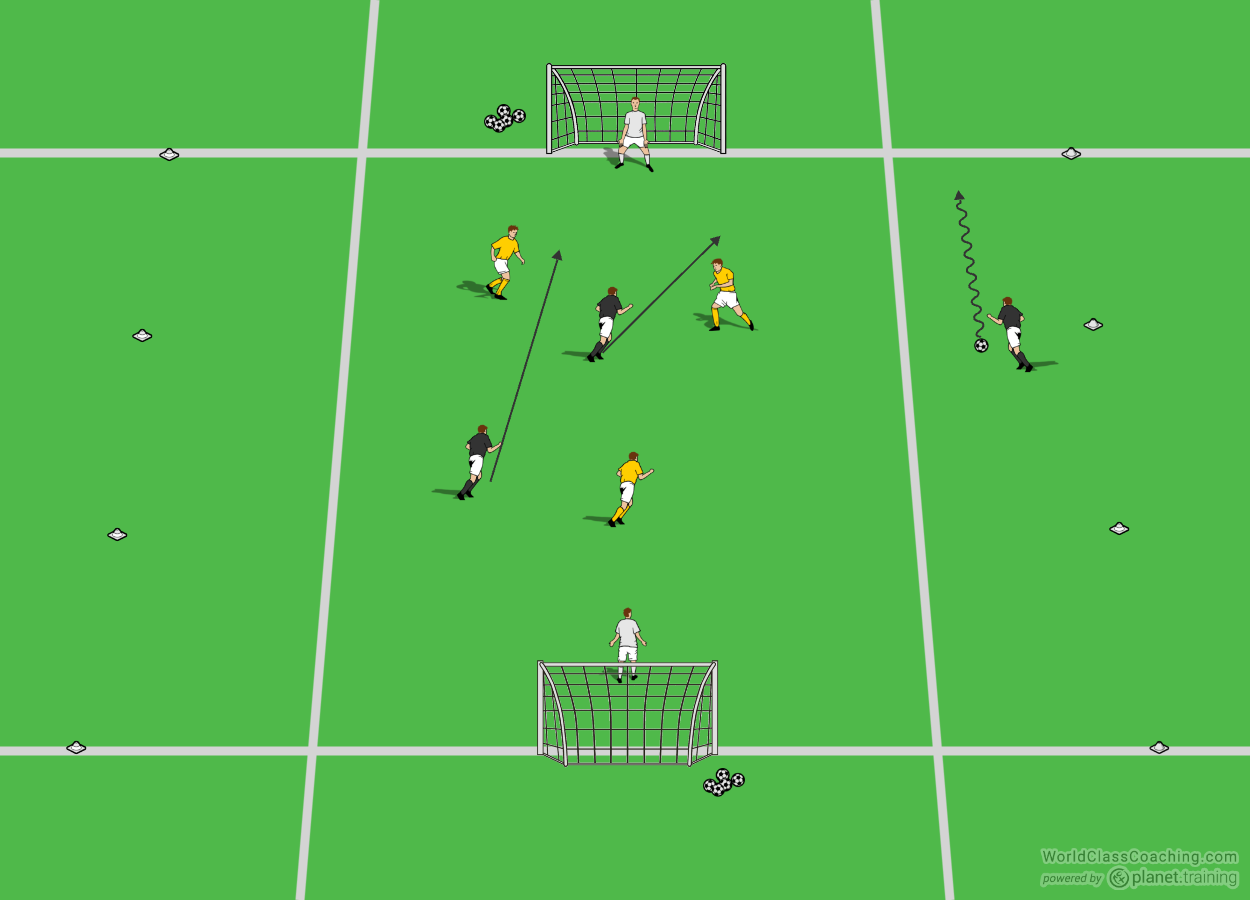
As the wide player is about to deliver the ball, the other players should look to make explosive forward movements to finish. If the ball goes out for a corner, it is restarted from the opposite goalkeeper (no corners).
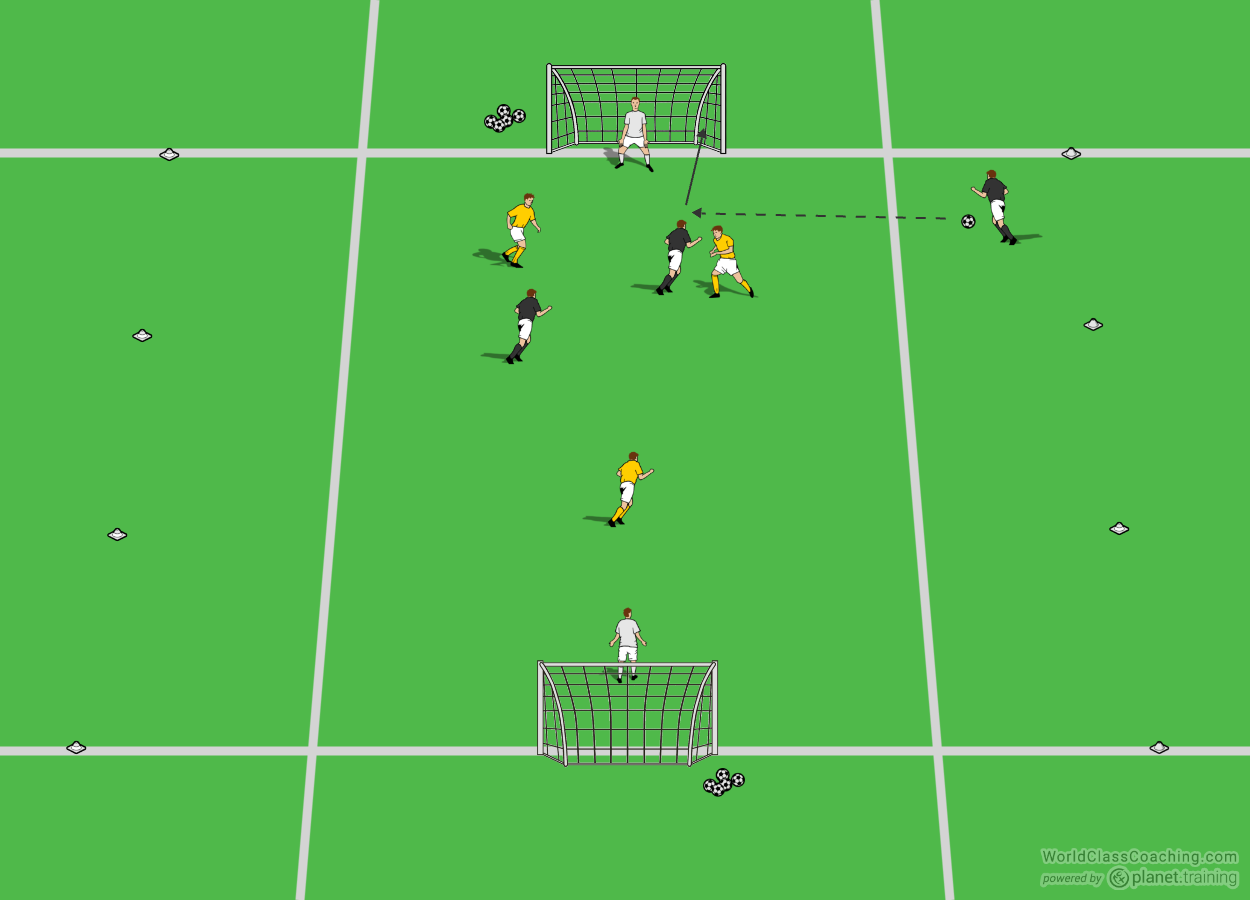
Timing
The practice should last 1-3 minutes and be repeated 6-10 times in 2 series. Rest between repetitions should be 1-3 minutes and between series, 4 minutes.
Variations
- 4v4/3v3+1
- Max. 2 entries into wide areas before a finish
- Min. 2 passes before the ball can be played wide
By Alex Trukan, Development Coach, Nottingham Forest
@AlexTrukan
